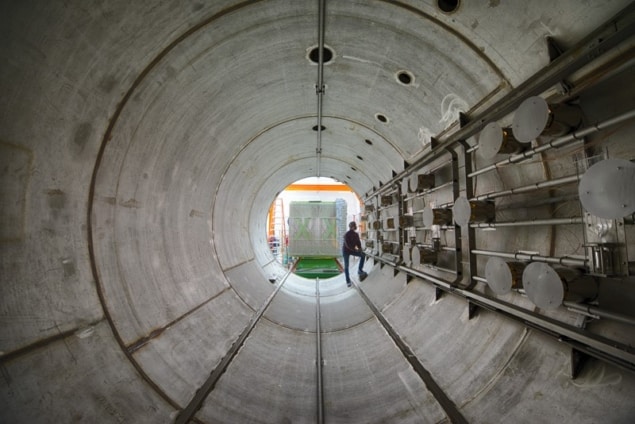Sterile neutrinos ruled out by MicroBooNE, but mysterious excess remains unexplained
28 Oct 2021 Hamish Johnston
Neutrino physics has rarely been straightforward, and many surprises – and four Nobel prizes – have emerged in the 90 years since the particle was first proposed. Now, it looks like the first results from the MicroBooNE neutrino detector at Fermilab in the US are keeping the faith with this tradition.
A series of papers from the MicroBooNE collaboration suggest that mysterious signals seen in two other neutrino detectors are not the result of sterile neutrinos. The sterile neutrino is a hypothetical fourth type of neutrino and finding it would shake up our understanding of particle physics. Indeed, it would be the first particle outside of the Standard Model of particle physics to be discovered since the 1960s – and some physicists think sterile neutrinos could be a candidate for dark matter.
But don’t think that this is the end of the story. Those mysterious signals could instead be evidence for other exotic physics beyond the Standard Model – or even a different type of sterile neutrino.
Extremely difficult to detect
Neutrinos were first proposed in 1930 by Wolfgang Pauli to account for missing energy and spin in the beta decay of nuclei. Pauli famously apologised for proposing the neutrino because its weak interactions with matter would make it extremely difficult to detect. Indeed, it was not until 1956 that neutrinos were spotted in the lab. That was the electron neutrino, and now we know that two other types (or flavours) of neutrinos exist – the muon and the tau.
Discovering new particles is nice, but what is really exciting is the bizarre behaviour of neutrinos. This first came to light in the 1960s, when physicists began to build underground detectors to observe the copious amounts of electron neutrinos produced by the Sun. Researchers were faced with a glaring problem; far fewer electron neutrinos were being detected than predicted by the standard solar model.
This left physicists scratching their heads until the late 1990s when experiments in Japan and Canada began finding definitive evidence that a neutrino of one flavour can change into a neutrino of a different flavour – a process called neutrino oscillation. This oscillation occurs as electron neutrinos travel from the Sun, explaining why fewer than expected electron neutrinos are detected on Earth.
This solution to the solar neutrino problem changed the Standard Model of particle physics at the time. For oscillations to occur, neutrinos must have mass – and the Standard Model had assumed that neutrinos were massless.
Ideal hunting ground
This rich behaviour of neutrinos makes them an ideal hunting ground for even more physics beyond the Standard Model. For example, current and future neutrino experiments could shed light on one of the biggest mysteries facing physicists: why is there far more matter than antimatter in the universe? Studies that could help unlock the puzzle include searches for differences between neutrinos and their antimatter counterparts – antineutrinos.
So how do sterile neutrinos fit into all of this? Well, it is a bit like the solar neutrino problem all over again. Over the past two decades, two experiments that look at how neutrinos oscillate from one flavour to another have seen significant discrepancies between the number of neutrinos they detect, and the number predicted by our current understanding of neutrino oscillation.
One possible explanation is the existence of a fourth type of neutrino – the sterile neutrino – that can affect neutrino oscillation. The sterile neutrino would be even more difficult to detect because it would only interact with matter via gravity. This combined with the prediction that sterile neutrinos should have mass makes them a potential candidate for dark matter. So, any evidence for their existence is very exciting indeed.
Discovery level
This anomaly was first reported by the Liquid Scintillator Neutrino Detector (LSND) at the Los Alamos National Laboratory in New Mexico and then by the MiniBooNE experiment at Fermilab. For 15 years, MiniBooNE monitored how muon neutrinos created by an accelerator oscillate into electron neutrinos as they travel several hundred metres. In 2018, MiniBooNE physicists reported the detection of far more electron neutrinos than predicted by the Standard Model. When combined with previous measurements at LSND, the excess has a statistical significance of 6.1σ, which is well above the 5σ that is normally considered a discovery in particle physics.
However, other neutrino experiments have not seen the same excess and MiniBooNE was unable to say unambiguously that the signal came from electron neutrinos. The problem is that like all neutrino detectors, MiniBooNE does not detect neutrinos directly, but rather it detects particles that are created when neutrinos collide with atoms in the detector. In this case MiniBooNE was looking for electrons but could not distinguish them from photons that could arise from background effects.READ MORE

In 2015, the new MicroBooNE experiment began taking data at Fermilab, in part to try to settle the question of the anomaly. Crucially, MicroBooNE can track the particles created by neutrino collisions and can therefore discriminate between electrons and photons.
Now the experiment has reported its first results, which rule out electrons as the sole source of the excess at a confidence greater than 99%. So, it looks like LSND and MiniBooNE did not see evidence for sterile neutrinos.
But don’t despair, there is still hope for new physics because the new data have also ruled out the most likely explanation for a photon background signal to 95% confidence, which means that the excess is still very much a mystery. According to Fermilab, future analyses of MicroBooNE data could reveal evidence for dark matter, axion-like particles, or the hypothetical Z-prime boson and beyond. And there is still the chance that the signal is from sterile neutrinos behaving in unexpected ways.
from physicsworld.com 28/10/2021

Δεν υπάρχουν σχόλια:
Δημοσίευση σχολίου